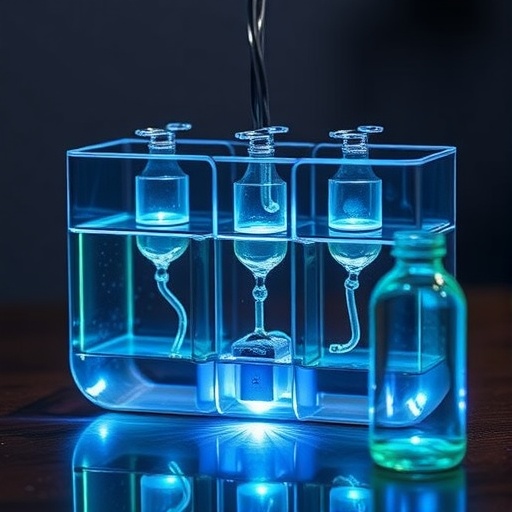In an extraordinary leap towards a sustainable future, researchers have made significant strides in hydrogen production. The innovative study, led by a team including David B. Adam, M.T. Kassa, and S.T. Gebreabe, explores a novel approach to hydrogen generation through hybrid water electrolysis. Their findings, published in the journal Ionics, delve into the intricacies of using a ruthenium-tin oxide electrocatalyst to optimize this critical process. This advancement holds the potential not only to enhance the efficiency of hydrogen production but also to pave the way for broader applications in clean energy solutions.
The process of hydrogen production is essential in the quest for renewable energy sources. Traditional methods of hydrogen generation often rely on fossil fuels or are plagued by inefficiencies. The team’s research emphasizes hybrid water electrolysis, a smarter approach that integrates both thermochemical and electrochemical methods. This hybridization aims to circumvent the limitations posed by conventional electrolysis, where high energy inputs can hinder performance and efficiency.
Ruthenium-tin oxide has emerged as a promising electrocatalyst in this study. By harnessing the unique properties of these materials, the research team aimed to dramatically improve the overall electrolysis process. The use of this specific catalyst allows for lower energy barriers during the reaction, sunlight-to-hydrogen conversion becomes more feasible, and understanding the mechanics behind these reactions reveals the potential of this hybrid model in large-scale production.
Understanding the mechanisms of the ruthenium-tin oxide catalyst is crucial in appreciating its functionality. The layered structure of this material contributes to higher stability and effectiveness during the electrocatalytic reactions. The results indicate that this catalyst not only enhances the rate at which hydrogen is produced but also maintains structural integrity over prolonged use, a common pitfall for many conventional catalysts.
One of the remarkable outcomes of this research is the enhanced energy conversion efficiency achieved. The hybrid electrolysis system provided a more integrated process for splitting water into hydrogen and oxygen, thus maximizing yield. With the introduction of the ruthenium-tin oxide catalyst, the efficiency numbers speak volumes. The ability to require less energy input while yielding substantial hydrogen production represents a dramatic departure from traditional methods.
By leveraging renewable energy sources such as solar and wind, this cutting-edge technique lays the foundation for sustainable hydrogen production. The implications for energy storage are profound. As renewable sources continue to proliferate, the ability to produce hydrogen, which can be stored and transported, offers a significant solution to the intermittent nature of wind and solar energy generation.
Furthermore, hydrogen plays a pivotal role not just as a fuel source but also as a feedstock in various industrial processes. From fertilizers to refineries, hydrogen’s versatility cannot be overstated. The hybrid approach promoted by this research could usher in a new era where hydrogen production is not only cost-effective but also environmentally responsible.
Additionally, the environmental impacts of hydrogen fuel contribute to its attractiveness. The use of water as a primary resource for hydrogen generation eliminates harmful emissions typically associated with fossil fuel-derived hydrogen. The study highlights how machine learning and simulation can optimize the catalyst’s performance further, augmenting the practical usability of the technology developed.
While the results of this research are promising, a vast array of future steps are crucial to move from laboratory success to real-world application. Scaling up the production of the ruthenium-tin oxide catalyst will be essential to meet the growing industrial demands. Moreover, further exploration into the economic aspects of hybrid water electrolysis will help to ensure the technology can compete effectively in the market.
The enthusiasm surrounding this innovation is palpable in the scientific community. With major investments and global interest directed toward hydrogen economy developments, this work arrives at a pinnacle moment. Collaborations between academia and industry could expedite the transition from research-driven concepts to field-ready solutions that can combat climate change.
As we navigate the challenges of a carbon-neutral future, breakthroughs in hydrogen production, particularly through methods like those explored in this study, hold significant promise. The implications of these findings resonate beyond laboratory walls. They serve as a rallying point for scientists, engineers, and policymakers who are increasingly recognizing hydrogen’s potential as a clean energy carrier.
In conclusion, the team’s work brings the promise of a more sustainable future into clearer focus. By advancing novel electrolysis techniques that utilize environmentally friendly materials, we can move closer to realizing a world where clean hydrogen becomes a cornerstone of our energy systems. As we await further developments in this domain, the foundations laid by this research may very well usher in a new age of energy production that is both efficient and sustainable.
Subject of Research: Advances in hydrogen production through innovative electrolysis techniques.
Article Title: Decoupled hydrogen production through hybrid water electrolysis utilizing ruthenium-tin oxide electrocatalyst.
Article References: Adam, D.B., Kassa, M.T., Gebreabe, S.T. et al. Decoupled hydrogen production through hybrid water electrolysis utilizing ruthenium-tin oxide electrocatalyst. Ionics (2025). https://doi.org/10.1007/s11581-025-06759-3
Image Credits: AI Generated
DOI: https://doi.org/10.1007/s11581-025-06759-3
Keywords: Hydrogen production, hybrid water electrolysis, ruthenium-tin oxide, electrocatalyst, renewable energy.




